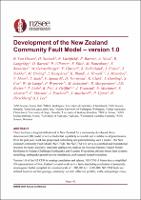Development of the New Zealand Community Fault Model – version 1.0
| dc.contributor.author | Van Dissen, Russ | |
| dc.contributor.author | Seebeck, Hannu | |
| dc.contributor.author | Litchfield, Nicola | |
| dc.contributor.author | Barnes, Philip | |
| dc.contributor.author | Nicol, Andy | |
| dc.contributor.author | Langridge, Robert | |
| dc.contributor.author | Barrell, David | |
| dc.contributor.author | Villamor, Pilar | |
| dc.contributor.author | Ellis, Susan | |
| dc.contributor.author | Rattenbury, Mark | |
| dc.contributor.author | Bannister, Stephen | |
| dc.contributor.author | Gerstenberger, Matt | |
| dc.contributor.author | Ghisetti, Francesca | |
| dc.contributor.author | Sutherland, Rupert | |
| dc.contributor.author | Fraser, Jeff | |
| dc.contributor.author | Nodder, Scott | |
| dc.contributor.author | Stirling, Mark | |
| dc.contributor.author | Humphrey, Jade | |
| dc.contributor.author | Bland, Kyle | |
| dc.contributor.author | Howell, Andrew | |
| dc.contributor.author | Mountjoy, Joshu | |
| dc.contributor.author | Moon, Vicki | |
| dc.contributor.author | Stahl, Tim | |
| dc.contributor.author | Spinardi, Francesca | |
| dc.contributor.author | Townsend, Dougal | |
| dc.contributor.author | Clark, Kate | |
| dc.contributor.author | Hamling, Ian | |
| dc.contributor.author | Cox, Simon | |
| dc.contributor.author | de Lange, William | |
| dc.contributor.author | Wopereis, Paul | |
| dc.contributor.author | Johnston, Mike | |
| dc.contributor.author | Morgenstern, Regine | |
| dc.contributor.author | Eccles, Jennifer | |
| dc.contributor.author | Little, Tim | |
| dc.contributor.author | Fry, Bill | |
| dc.contributor.author | Griffin, Jonathan | |
| dc.contributor.author | Townsend, John | |
| dc.contributor.author | Mortimer, Nick | |
| dc.contributor.author | Alcaraz, Samantha | |
| dc.contributor.author | Massiot, Cecile | |
| dc.contributor.author | Rowland, Julie | |
| dc.contributor.author | Muirhead, James | |
| dc.contributor.author | Upton, Phaedra | |
| dc.contributor.author | Hirschberg, Hamish | |
| dc.contributor.author | Lee, Julie | |
| dc.date.accessioned | 2021-06-22T04:01:54Z | |
| dc.date.available | 2021-06-22T04:01:54Z | |
| dc.date.issued | 2021-04-14 | |
| dc.identifier.uri | https://repo.nzsee.org.nz/xmlui/handle/nzsee/2366 | |
| dc.description.abstract | There has been a long-identified need in New Zealand for a community-developed three-dimensional fault model that is accessible and available to all. Over the past year, work has progressed on building and parameterising such a model – the New Zealand Community Fault Model (NZ CFM). The NZ CFM will serve as a unified and foundational resource for many societally important applications such as the National Seismic Hazard model, Resilience to Natures Challenges Earthquake and Tsunami Programme (synthetic earthquakes project), physics-based fault systems modelling, earthquake ground-motion simulations, and tsunami hazard evaluation. Version 1.0 of the NZ CFM is nearing finalisation and release. NZ CFM v1.0 provides a simplified 3D representation of New Zealand’s crustal-scale active faults (including a selection of potentially seismogenic faults) compiled at a nominally scale of 1:500,000 to 1:1,000,000. NZ CFM faults are defined based on surface traces, seismicity, seismic reflection profiles, wells, and geologic cross sections following methodologies developed by the Southern California Earthquake Center. The model presently incorporates more than 800 objects (i.e., faults), which include triangulated surface representations of those faults linked to parameters such as dip and dip direction, seismogenic rupture depth, sense of movement, slip direction, and net slip rate. Here we present an overview of NZ CFM v1.0 including the formulation, parameterisation and documentation of that model in 3D; and the availability of that model in a readily accessible form(s) to support and facilitate multiple realisations and varied applications. More information about this project can be found at: https://www.gns.cri.nz/nzcfm | |
| dc.language.iso | en | |
| dc.publisher | New Zealand Society for Earthquake Engineering | |
| dc.relation.ispartofseries | 2021;0092 | |
| dc.subject | Improving understanding of seismic hazard and risk | |
| dc.title | Development of the New Zealand Community Fault Model – version 1.0 | |
| dc.type | Article |

